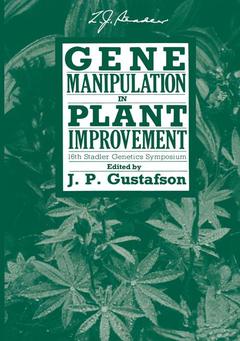Description
Gene Manipulation in Plant Improvement, 1984
16th Stadler Genetics Symposium
Stadler Genetics Symposia Series
Coordinator: Gustafson J. Perry
Language: English
Subjects for Gene Manipulation in Plant Improvement:
Keywords
Chromosom; Evolution; Mutation; gene expression; genes; hybridization; nitrogen; wheat; Tree Biology
Publication date: 07-2013
668 p. · 17.8x25.4 cm · Paperback
668 p. · 17.8x25.4 cm · Paperback
Description
/li>Contents
/li>
The results obtained to date involving the use of in ~ methods to facilitate wide hybridization in plants are voluminous and impressive. The techniques of embryo culture, ovule culture, and in~ pollination and fertilization represent an extension of the normal sexual hybridization process. Successes recorded in obtaining hybrids stem largely from circumventing prezygotic or postzygotic hybridization barriers. Numerous recent successful hybridizations were possible because of the development of improved tissue and cell culture systems for crop plants and attention given to genotypes used in hybridization attempts. Interspecific and intergeneric hybridization utilizing the process of protoplast fusion will bypass the limits set by all sexual me'thods. In addition to combining complete genomes from two different species through protoplast fusion, this system affords unique opportunities for creating novel cytoplasmic combinations, transfer of individual chromosomes, transfer of cytoplasmic organelles, manipulation of male sterility, and for single gene transfer. Some caution must be noted with regard to the extent of hybridization possible between distantly related species. Although practically no limit exists to the physical fusion of protoplasts from widely divergent species, the restrictions imposed by somatic incompatibility have not been adequately addressed. Regeneration of plants from the protoplast or single heterokaryon level is still a major hurdle for many important crop species before somatic cell fusion can be exploited to produce interspecific and intergeneric hybrids. Identification and selection of hybrids is also a limitation to the efficient application of cell fusion methods.
Plant Breeding 1910–1984.- Progress in Conventional Plant Breeding.- Philosophy and Methodology of an International Wheat Breeding Program.- IRRI Breeding Program and Its Worldwide Impact on Increasing Rice Production.- Ideotype Research and Plant Breeding.- Physiological Aspects of Varietal Improvement.- Quantitative Genetic Principles in Plant Breeding.- The Pathological and Entomological Framework of Plant Breeding.- The Genomic System of Classification as a Guide to Intergeneric Hybridization with the Perennial Triticeae.- Evolutionary Relationships and Their Influence on Plant Breeding.- Mutations in Wheat That Raise the Level of Meiotic Chromosome Pairing.- Chromosome Manipulation in Plant Breeding: Progress and Prospects.- InVitro Approaches to Interspecific Hybridization and Chromosome Manipulation in Crop Plants.- The Significance of Doubled Haploid Variation.- Use of Protoplasts: Potentials and Progress.- Somaclonal Variation: Theoretical and Practical Considerations.- Nuclear Architecture and Its Manipulation.- Selecting Better Crops from Cultured Cells.- Molecular Analysis of Alien Chromatin Introduced into Wheat.- Genetic Aspects of Symbiotic Nitrogen Fixation.- Chlamydomonasreinhardii, A Potential Model System for Chloroplast Gene Manipulation.- Toward An Understanding of Gene Expression in Plants.- Perspectives on Genetic Manipulation in Plants.- Gene Manipulation and Plant Breeding.- 16th Stadler Genetic Symposium Posters.
© 2024 LAVOISIER S.A.S.
These books may interest you

Maize 231.05 €



